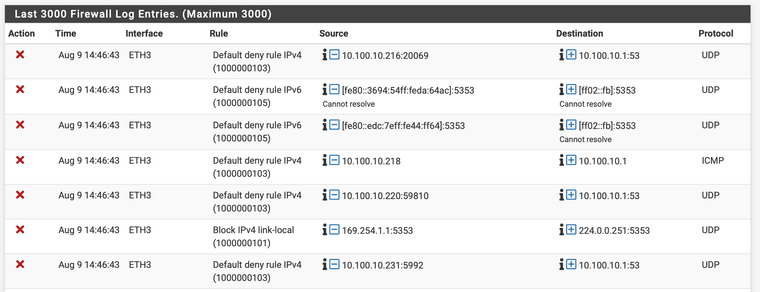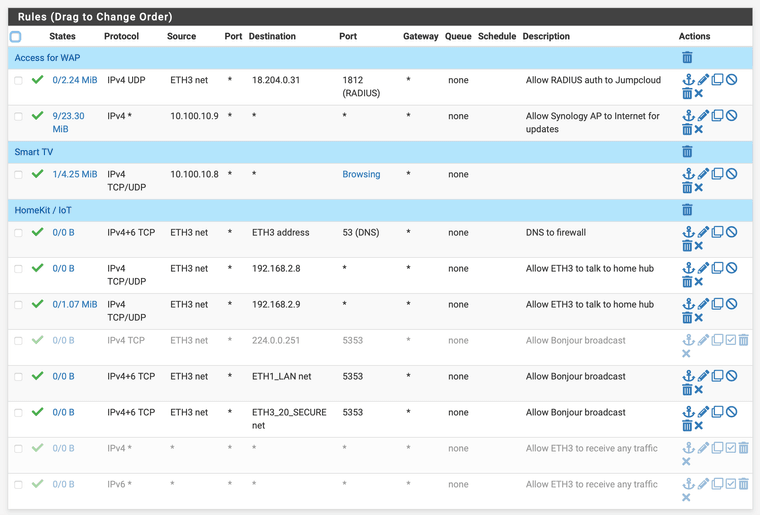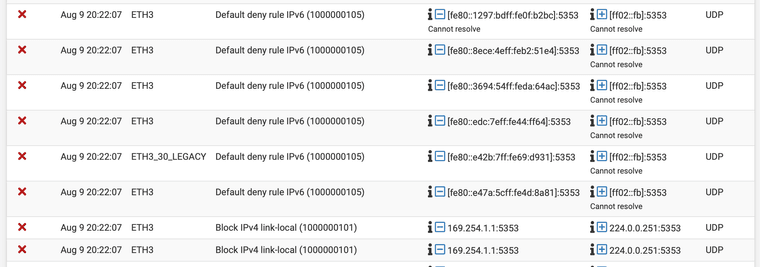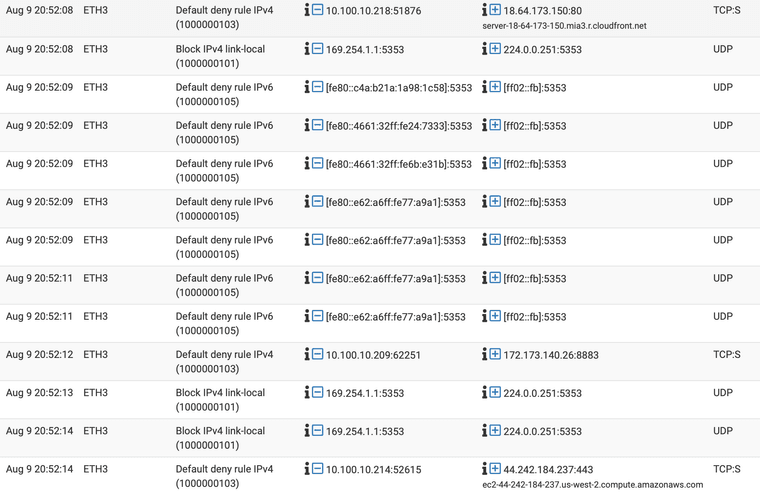Rules to allow Homekit across vlan
-
@tknospdr yeah this firewall would allow access to any and all pfsense IPs, and the eth3 address would only allow access to the eth3 address.
-
@johnpoz Not really. In the above example it can resolve DNS requests on the port listed using TCP/UDP. It does not give the VLAN access to all addresses.
 ️
️ -
@RobbieTT said in Rules to allow Homekit across vlan:
TCP/UDP. It does not give the VLAN access to all addresses.
It does on port 53.. That rule says you can go to any IP on pfsense on port 53..
https://forum.netgate.com/post/708897
"This Firewall (self)" does what it says – It's every address on the firewall already. It's a pf macro that refers to the firewall host and any address it has, collectively.
-
@johnpoz said in Rules to allow Homekit across vlan:
@tknospdr yeah this firewall would allow access to any and all pfsense IPs, and the eth3 address would only allow access to the eth3 address.
I understand the difference, I was asking if in this particular case would it make a difference to the outcome of that rule to choose one or the other.
Anyway, here's my latest deny's, and what my current rules look like.



-
@tknospdr said in Rules to allow Homekit across vlan:
case would it make a difference to the outcome of that rule to choose one or the other.
No not really the "this firewall" would allow access to your eth3 address. But I wouldn't use the rule like that.. If your clients are going to use eth3 address as their dns, then that is what the rule should say. Why would they be using other IP on pfsense, other than the IP of pfsense in their network..
I use the this firewall in my rules as a reject when I don't want say my non trusted networks/vlans being able to access the web gui, etc. I have explicit rules to what specific networks are allowed to go to, and then block all other access to the firewall. the this firewall is good for that, along with an alias of rfc1918 networks in blocking networks/vlans from talking to your other networks/vlans.
Your dns rule there is set to tcp only - so yeah UDP would be blocked. DNS is almost always UDP.. TCP is a fallback, and used when whatever is going to be queried answer is too large for UDP.. That rule should be udp/tcp or if you just want 1 then it should be UDP.
Your rules on eth3 for 5353 are pretty pointless - those are going to be multicast.. And zero reason to let pfsense even see that traffic unless your going to be using avahi to pass it on to some other network. But the way those rules are written wouldn't be of any good.
your floating rule for 224.0.0.251 should allow your mdns via avahi.. But you could limit that rule down to 5353
edit:
keep in mind the 5353 with avahi would allow discovery, but your going to actually need a rule to allow whatever port(s) your service your going to actually be accessing once discovered. -
@johnpoz said in Rules to allow Homekit across vlan:
Your dns rule there is set to tcp only - so yeah UDP would be blocked. DNS is almost always UDP.. TCP is a fallback, and used when whatever is going to be queried answer is too large for UDP.. That rule should be udp/tcp or if you just want 1 then it should be UDP.
Thanks, changed it to both, now I have a different set of deny's taking place on my FW. Screenshot incoming...
Your rules on eth3 for 5353 are pretty pointless - those are going to be multicast.. And zero reason to let pfsense even see that traffic unless you're going to be using avahi to pass it on to some other network. But the way those rules are written wouldn't be of any good.
Okay, so I don't need them at all with the floating rule I have? I created those based on another thread I found here suggesting them.
your floating rule for 224.0.0.251 should allow your mdns via avahi.. But you could limit that rule down to 5353
Yes, I'm using Avahi on the 3 networks that need to interact for HomeKit/IoT.
edit:
keep in mind the 5353 with avahi would allow discovery, but your going to actually need a rule to allow whatever port(s) your service your going to actually be accessing once discovered.And what ports would those be?
There are a bunch of threads that say what not to do, but no definitive recipes on how to make HomeKit bombproof. -
Still getting a lot of blocked traffic for 5353, what am I missing?

I'm also seeing a bunch of NTP requests to random IP addresses. Is it safe to allow port 123 to any dest?

And why do some of my bulbs and switches want to talk to random AWS or CF servers?

-
Alright, some more info...
I found the thread on here talking about ff02::fb and how it's a link local address for IPv6. I created a pass rule for it and it disappeared from my logs.
I still have a bunch of outgoing requests from my smart devices to different servers such as aaplimg.com, akamaitechnologies.com, etc.
I'm guessing they're checking for FW updates and such and not being nefarious??Also, I figured out the mystery of why 2 of my devices went offline. After combing over the FW rules and logs for a while last night I found out that my 9 year old accidentally unplugged the extension cord those 2 were plugged into.
Ugh. -
If Homekit hub is in IoT vlan, what rules are needed for clients to access the hub?
Will this be easier than having separate vlans? -
@moosport said in Rules to allow Homekit across vlan:
If Homekit hub is in IoT vlan, what rules are needed for clients to access the hub?
As far as I know, none. If the FW is not being traversed and you don't make any specific block or drop rules then all traffic is allowed.
Will this be easier than having separate vlans?
Sort of, I have 2 home hubs, one is on the same VLAN due to location, and the other (main one) can't be as it's plugged into my ethernet segment and wired and wireless are physically separate.
That doesn't really answer any of my most recent questions though...